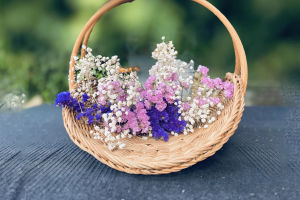Since the 15th century in Europe, a romantic tradition of courtship emerged, where men would pick flowers along the way to present to their beloved women.
If accepted, the woman would pin the most beautiful flower to her chest. Over time, this custom evolved into the wedding bouquet and corsage, becoming integral to wedding ceremonies.
Today, bridal bouquets symbolize the couple's love and future happiness. They serve as witnesses to the joyous moment shared between the bride and groom. Moreover, catching the bouquet thrown by the bride is believed to bring luck in finding love for single friends attending the wedding.
Different shapes of hand bouquets cater to various styles and preferences. The semi-spherical bouquet, ideal for traditional weddings, complements waist-tight dresses and smaller brides. The waterfall bouquet, characterized by cascading flowers, suits brides with "A"-shaped hemlines for its flowing elegance.
Meanwhile, the triangle bouquet, featuring three rings of varying lengths, offers a chic and innovative style, perfect for taller brides.
Selecting the right flowers for the hand bouquet is crucial. For weddings with predominantly white dresses, colorful bouquets add vibrancy and contrast. Conversely, an all-white bouquet can enhance the sense of purity and holiness. Additionally, consider incorporating green leaves for balance.
For flower ceremonies, ball bouquets with long ribbons create a dramatic effect when thrown. When choosing a bouquet, ensure it complements the wedding dress and decorations, reflecting a cohesive aesthetic.
For dresses with elaborate designs, opt for simpler bouquets to avoid overwhelming the ensemble. However, for simpler dresses, colorful bouquets can add a pop of excitement.
When using a waterfall bouquet, especially with trailing elements, take precautions to prevent damage. Secure each flower with floral glue and use wire to stabilize the stems, ensuring durability throughout the event.
In essence, hand bouquets not only enhance the bride's attire but also symbolize the beauty of love and commitment shared on the wedding day. By carefully selecting and crafting these floral arrangements, couples can add a touch of elegance and sentiment to their special celebration.
Each flower carries its own meaning, allowing couples to convey specific messages through their choice of blooms. For example, roses symbolize love and romance, making them a popular choice for bridal bouquets.
Peonies represent prosperity and good fortune, while lilies signify purity and virtue. By incorporating flowers with significant meanings, couples can infuse their wedding bouquets with personal significance and intention.
The seasonality of flowers plays a crucial role in bouquet selection. Opting for flowers that are in season not only ensures freshness but also reduces costs and environmental impact. Seasonal blooms also add a touch of authenticity and harmony to the overall wedding theme, connecting the celebration to the natural rhythms of the earth.
Couples may choose to incorporate non-floral elements into their hand bouquets for added texture and visual interest. Foliage, berries, feathers, and even succulents can complement floral arrangements, adding depth and dimension to the bouquet.
These unconventional elements can also reflect the couple's unique style and personality, creating a one-of-a-kind bouquet that truly stands out.
Ultimately, the hand bouquet serves as a meaningful accessory that enhances the bride's beauty and complements the wedding theme.


